New Ti–35Nb–7Zr–5Ta Alloy Manufacturing by Electron Beam Melting for Medical Application Followed by High Current Pulsed Electron Beam Treatment
Abstract
1. Introduction
2. Materials and Methods
2.1. EBM Fabrication and PEB Treatment of TNZT Samples
2.2. Characterization of the Samples
2.3. Corrosion Test
2.4. Mechanical Test
3. Results and Discussion
3.1. Powder Characterization
3.2. Morphology, Microstructure, and Phase Composition of TNZT Alloy
3.3. Corrosion Test Results
3.4. Mechanical Properties
4. Conclusions
Author Contributions
Funding
Data Availability Statement
Acknowledgments
Conflicts of Interest
References
- Niinomi, M. Recent research and development in titanium alloys for biomedical applications and healthcare goods. Sci. Technol. Adv. Mater. 2003, 4, 445–454. [Google Scholar] [CrossRef]
- Long, M.; Rack, J. Titanium alloys in total joint replacement—A materials science perspective. Biomaterials 1998, 19, 1621–1639. [Google Scholar] [CrossRef]
- Kurtz, S.; Ong, K.; Lau, E.; Mowat, F.; Halpern, M. Projections of primary and revision hip and knee arthroplasty in the United States from 2005 to 2030. J. Bone Jt. Surg. 2007, 89, 780–785. [Google Scholar] [CrossRef]
- Brehme, H.J. Titanium and titanium alloys, biomaterials of preference. Mémoires études Sci. Rev. Métallurgie 1989, 86, 625–637. [Google Scholar]
- De Gélas, B.; Molinier, R.; Séraphin, L.; Armand, M.; Tricot, R. A Titanium Alloy with Improved Mechanical Resistance Ti-6A1-6V-2Sn-6Zr. In Titanium and Titanium Alloys; Springer: Boston, MA, USA, 1982; pp. 2121–2130. [Google Scholar]
- Sowa, M.; Parafiniuk, M.; Mouzelo, C.M.S.; Kazek-KęsikaIvan, A.; Zhidkov, I.S.; Kukharenko, A.I.; Cholakh, O.; Kurmaev, E.Z.; Simka, E. DC plasma electrolytic oxidation treatment of gum metal for dental implants. Electrochim. Acta 2019, 302, 10–20. [Google Scholar] [CrossRef]
- Lee, Y.-S.; Niinomi, M.; Nakai, M.; Narita, K.; Cho, K. Predominant factor determining wear properties of β-type and (α+β)-type titanium alloys in metal-to-metal contact for biomedical applications J. Mech. Behav. Biomed. Mater. 2015, 41, 208–220. [Google Scholar] [CrossRef]
- Ahmadi, S.M.; Hedayati, R.; Ashok Kumar Jain, R.K.; Li, Y.; Leeflang, S.; Zadpoor, A.A. Effects of laser processing parameters on the mechanical properties, topology, and microstructure of additively manufactured porous metallic biomaterials: A vector-based approach. Mater. Des. 2017, 134, 234–243. [Google Scholar] [CrossRef]
- Banerjee, R.; Nag, S.; Samuel, S.; Fraser, H.L. Laser-deposited Ti-Nb-Zr-Ta orthopedic alloys. J. Biomed. Mater. Res. Part A 2006, 78, 298–305. [Google Scholar] [CrossRef] [PubMed]
- Murr, L.E.; Gaytan, S.M.; Ceylan, A.; Martinez, E.; Martinez, J.L.; Hernandez, D.H.; Machado, B.I.; Ramirez, D.A.; Medina, F.; Collins, S.; et al. Characterization of titanium aluminide alloy components fabricated by additive manufacturing using electron beam melting. Acta Mater. 2010, 58, 1887–1894. [Google Scholar] [CrossRef]
- Chan, K.S.; Koike, M.; Mason, R.L.; Okabe, T. Fatigue life of titanium alloys fabricated by additive layer manufacturing techniques for dental implants. Metall. Mater. Trans. A 2013, 44, 1010–1022. [Google Scholar] [CrossRef]
- Liu, X.; Chu, P.K.; Ding, C. Surface modification of titanium, titanium alloys, and related materials for biomedical applications. Mater. Sci. Eng. 2004, 47, 49–121. [Google Scholar] [CrossRef]
- Niinomi, M.; Liu, Y.; Nakai, M.; Liu, H.; Li, H. Biomedical titanium alloys with Young’s moduli close to that of cortical bone. Regen. Biomater. 2016, 3, 173–185. [Google Scholar] [CrossRef] [PubMed]
- Nakai, M.; Niinomi, M.; Akahori, T.; Ohtsu, N.; Nishimura, H.; Toda, H. Surface hardening of biomedical Ti-29Nb-13Ta-4.6 Zr and Ti-6Al-4V ELI by gas nitriding. Mater. Sci. Eng. A 2008, 486, 193–201. [Google Scholar] [CrossRef]
- Mridha, S.; Baker, T. Effects of nitrogen gas flow rates on the microstructure and properties of laser-nitrided IMI318 titanium alloy (Ti-4V-6Al). J. Mater. Process. Technol. 1998, 77, 115–121. [Google Scholar] [CrossRef]
- Rastkar, A.; Bell, T. Characterization and tribological performance of oxide layers on a gamma based titanium aluminide. Wear 2005, 258, 1616–1624. [Google Scholar] [CrossRef]
- Wang, Y.; Qian, Z.; Li, X.; Tandon, K. Sliding wear properties of TiAl alloys with/without TiN coatings. Surf. Coat. Technol. 1997, 91, 37–42. [Google Scholar] [CrossRef]
- Oliveira, N.T.; Guastaldi, F.P.; Perrotti, V.; Hochuli-Vieira, E.; Guastaldi, A.C.; Piattelli, A.; Lezzi, G. Biomedical Ti-Mo alloys with surface machined and modified by laser beam: Biomechanical, histological, and histometric analysis in rabbits. Clin. Implant Dent. Relat. Res. 2013, 15, 427–437. [Google Scholar] [CrossRef]
- Zhang, X.; Hao, S.; Li, X.; Dong, C.; Grosdidier, T. Surface modification of pure titanium by pulsed electron beam. Appl. Surf. Sci. 2011, 257, 5899–5902. [Google Scholar] [CrossRef]
- Proskurovsky, D.; Rotshtein, V.; Ozur, G.; Ivanov, Y.F.; Markov, A. Physical foundations for surface treatment of materials with low energy, high current electron beams. Surf. Coat. Technol. 2000, 125, 49–56. [Google Scholar] [CrossRef]
- Gao, Y. Surface modification of TA2 pure titanium by low energy high current pulsed electron beam treatments. Appl. Surf. Sci. 2011, 257, 7455–7460. [Google Scholar] [CrossRef]
- Koval, N.N.; Ivanov, Y.F. Nanostructuring of surfaces of metalloceramic and ceramic materials by electron beams. Russ. Phys. J. 2008, 51, 505–516. [Google Scholar] [CrossRef]
- Uglov, V.V.; Kuleshov, A.K.; Soldatenko, E.A.; Koval, N.N.; Ivanov, Y.F.; Teresov, A.D. Structure, phase composition and mechanical properties of hard alloy treated by intense pulsed electron beams. Surf. Coat. Technol. 2012, 206, 2972–2976. [Google Scholar] [CrossRef]
- Rechtin, J.; Torresani, E.; Ivanov, E.; Olevsky, E. Fabrication of titanium-niobium-zirconium-tantalium alloy (TNZT) bioimplant components with controllable porosity by spark plasma sintering. Materials 2018, 11, 181. [Google Scholar] [CrossRef]
- Surmeneva, M.A.; Koptyug, A.; Khrapov, D.; Ivanov, Y.F.; Mishurov, T.; Evsevleev, S.; Prymak, O.; Loza, K.; Epple, M.; Bruno, G.; et al. In situ synthesis of a binary Ti-10at% Nb alloy by electron beam melting using a mixture of elemental niobium and titanium powders. J. Mater. Process. Technol. 2020, 282, 116646. [Google Scholar] [CrossRef]
- Chen, S.Y.; Huang, J.C.; Pan, C.T.; Lin, C.H.; Yang, T.L.; Huang, Y.S.; Ou, C.H.; Chen, L.Y.; Lin, D.Y.; Lin, H.K.; et al. Microstructure and mechanical properties of open-cell porous Ti-6Al-4V fabricated by selective laser melting. J. Alloys Compd. 2017, 713, 248–254. [Google Scholar] [CrossRef]
- Algardh, J.K.; Horn, T.; West, H.; Aman, R.; Snis, A.; Engqvist, H.; Lausmaa, J.; Harrysson, O. Thickness dependency of mechanical properties for thin-walled titanium parts manufactured by Electron Beam Melting (EBM)®. Addit. Manuf. 2016, 12, 45–50. [Google Scholar] [CrossRef]
- Karlsson, J.; Snis, A.; Engqvist, H.; Lausmaa, J. Characterization and comparison of materials produced by Electron Beam Melting (EBM) of two different Ti-6Al-4V powder fractions. J. Mater. Process. Technol. 2013, 213, 2109–2118. [Google Scholar] [CrossRef]
- Fischer, M.; Joguet, D.; Robin, G.; Peltier, L.; Laheurte, P. In situ elaboration of a binary Ti-26Nb alloy by selective laser melting of elemental titanium and niobium mixed powders. Mater. Sci. Eng. C 2016, 62, 852–859. [Google Scholar] [CrossRef] [PubMed]
- Barret, C.S.; Massalski, T.B. Structure of Metals; Pergamon Press: Oxford, UK, 1980. [Google Scholar]
- Varin, R.A.; Bystrzycki, J.; Calka, A. Effect of annealing on the microstructure, ordering and microhardness of ball milled cubic (L12) titanium trialuminide intermetallic powder. Intermetallics 1999, 7, 785–796. [Google Scholar] [CrossRef]
- Dongol, M.; El-Denglawey, A.; Elhady, A.F.; Abuelwafa, A.A. Structural properties of nano 5, 10, 15, 20-Tetraphenyl-21H, 23H-porphine nickel (II) thin films. Curr. Appl. Phys. 2012, 12, 1334–1339. [Google Scholar] [CrossRef]
- Laugier, J.; Bochu, B. LMGP-Suite of Programs for the Interpretation of Xray Experiments; BP46.38042; ENSP/Laboratories des Materiaux et du Genie Physique: Saint Martin d’Heres, France, 2000. [Google Scholar]
- Stokes, A.R.; Wilson, A.J.C. The diffraction of X rays by distorted crystal aggregates-I. Proc. Phys. Soc. 1944, 56, 174–181. [Google Scholar] [CrossRef]
- Hernandez, J.; Li, S.J.; Martinez, E.; Murr, L.E.; Pan, X.M.; Amato, K.N.; Cheng, X.Y.; Yang, F.; Terrazas, C.A.; Gaytan, S.M.; et al. Microstructures and hardness properties for β-phase Ti-24Nb-4Zr-7.9 Sn alloy fabricated by electron beam melting. J. Mater. Sci. Technol. 2013, 29, 1011–1017. [Google Scholar]
- Kim, J.; Park, H.W. Influence of a large pulsed electron beam (LPEB) on the corrosion resistance of Ti-6Al-7Nb alloys. Corros. Sci. 2015, 90, 153–160. [Google Scholar] [CrossRef]
- Chen, Z.; Liu, Y.; Wu, H.; Zhang, W.; Guo, W.; Tang, H.; Liu, N. Microstructures and wear properties of surface treated Ti-36Nb-2Ta-3Zr-0.35 O alloy by electron beam melting (EBM). Appl. Surf. Sci. 2015, 357, 2347–2354. [Google Scholar] [CrossRef]
- Zhang, T.C.; Zhang, K.M.; Zou, J.X.; Yan, P.; Yang, H.Y.; Song, L.X.; Zhang, X. Surface microstructure and property modifications in a Mg-8Gd-3Y-0.5 Zr magnesium alloy treated by high current pulsed electron beam. J. Alloys Compd. 2019, 788, 231–239. [Google Scholar] [CrossRef]
- Sinyakova, E.A.; Panin, A.V.; Perevalova, O.B.; Shugurov, A.R.; Kalashnikov, M.P.; Teresov, A.D. The effect of phase transformations on the recovery of pulsed electron beam irradiated Ti-6Al-4V titanium alloy during scratching. J. Alloys Compd. 2019, 795, 275–283. [Google Scholar] [CrossRef]
- Taddei, E.B.; Henriques, V.A.R.; Da Silva, R.M.; Cairo, C.A.A. Age-hardening of Ti-35Nb-7Zr-5Ta alloy for orthopaedic implants. Mater. Res. 2007, 10, 289–292. [Google Scholar] [CrossRef][Green Version]
- Guo, S.; Meng, Q.; Zhao, X.; Wei, Q.; Xu, H. Design and fabrication of a metastable β-type titanium alloy with ultralow elastic modulus and high strength. Sci. Rep. 2015, 5, 14688. [Google Scholar] [CrossRef] [PubMed]
- Nag, S.; Banerjee, R.; Srinivasan, R.; Hwang, J.Y.; Harper, M.; Fraser, H.L. Omega-Assisted nucleation and growth of α precipitates in the Ti–5Al–5Mo–5V–3Cr–0.5Fe β titanium alloy. Acta Mater. 2009, 57, 2136–2147. [Google Scholar] [CrossRef]
- Baker, H. Introduction to Alloy Phase Diagrams; ASM International: Materials Park, OH, USA, 1992; p. 1.1. [Google Scholar]
- Li, Y.; Qi, J.; Fan, R.R.; Zhai, C.X.; Xu, C.H. In Situ TEM Observation of Phase Transformation for Bio-Medical Shape Memory TiNbSn Alloy. Adv. Mater. Res. 2010, 152, 1755–1758. [Google Scholar] [CrossRef]
- Salvo, C.; Aguilar, C.; Cardoso-Gil, R.; Medina, A.; Bejar, L.; Mangalaraja, R. Study on the microstructural evolution of Ti-Nb based alloy obtained by high-energy ball milling. J. Alloys Compd. 2017, 720, 254–263. [Google Scholar] [CrossRef]
- Bahador, A.; Saud, S.; Hamzah, E.; Abubakar, T.; Yusof, F.; Ibrahim, M.K. Nd:YAG laser welding of Ti-27 at.% Nb shape memory alloys. Weld. World 2016, 60, 1133–1139. [Google Scholar] [CrossRef]
- Zhang, K.M.; Zou, J.X.; Grosdidier, T.; Dong, C.; Yang, D. Improved pitting corrosion resistance of AISI 316L stainless steel treated by high current pulsed electron beam. Surf. Coating. Technol. 2006, 201, 1393–1400. [Google Scholar] [CrossRef]
- Banerjee, R.; Nag, S.; Stechschulte, J.; Fraser, H.L. Strengthening mechanisms in Ti-Nb-Zr-Ta and Ti-Mo-Zr-Fe orthopaedic alloys. Biomaterials 2004, 25, 3413–3419. [Google Scholar] [CrossRef]
- You, L.; Song, X. A study of low Young′s modulus Ti–Nb–Zr alloys using d electrons alloy theory. Scr. Mater. 2012, 67, 57–60. [Google Scholar] [CrossRef]
- Surmeneva, M.; Surmenev, R.; Tyurin, A.; Mukhametkaliyev, T.; Teresov, A.; Koval, N.; Pirozhkova, T.; Shuvarin, I.; Oehr, C. Comparative study of the radio-frequency magnetron sputter deposited CaP films fabricated onto acid-etched or pulsed electron beam-treated titanium. Thin Solid Films 2014, 571, 218–224. [Google Scholar] [CrossRef]
- Xie, Y.X.K.; Wang, Y.; Zhao, Y.; Chang, L.; Wang, G.; Chen, Z.; Cao, Y.; Liao, X.; Lavernia, E.J.; Valiev, R.Z.; et al. Nanocrystalline β-Ti alloy with high hardness, low Young’s modulus and excellent in vitro biocompatibility for biomedical applications. Mater. Sci. Eng. C 2013, 33, 3530–3536. [Google Scholar] [CrossRef] [PubMed]
- Narayanan, T.S.; Kim, J.; Park, H.W. High performance corrosion and wear resistant Ti-6Al-4V alloy by the hybrid treatment method. Appl. Surf. Sci. 2020, 504, 144388. [Google Scholar] [CrossRef]
- Yao, Y.; Li, X.; Wang, Y.; Zhao, W.; Li, G.; Liu, R. Microstructural evolution and mechanical properties of Ti–Zr beta titanium alloy after laser surface remelting. J. Alloys Compd. 2014, 583, 43–47. [Google Scholar] [CrossRef]
- Zhang, X.D.; Zou, J.X.; Weber, S.; Hao, S.Z.; Dong, C.; Grosdidier, T. Microstructure and property modifications in a near α Ti alloy induced by pulsed electron beam surface treatment. Surf. Coat. Technol. 2011, 206, 295–304. [Google Scholar] [CrossRef]
- Marczewski, M.; Miklaszewski, A.; Maeder, X.; Jurczyk, M. Crystal Structure Evolution, Microstructure Formation, and Properties of Mechanically Alloyed Ultrafine-Grained Ti-Zr-Nb Alloys at 36 ≤ Ti ≤ 70 (at. %). Materials 2020, 13, 587. [Google Scholar] [CrossRef] [PubMed]

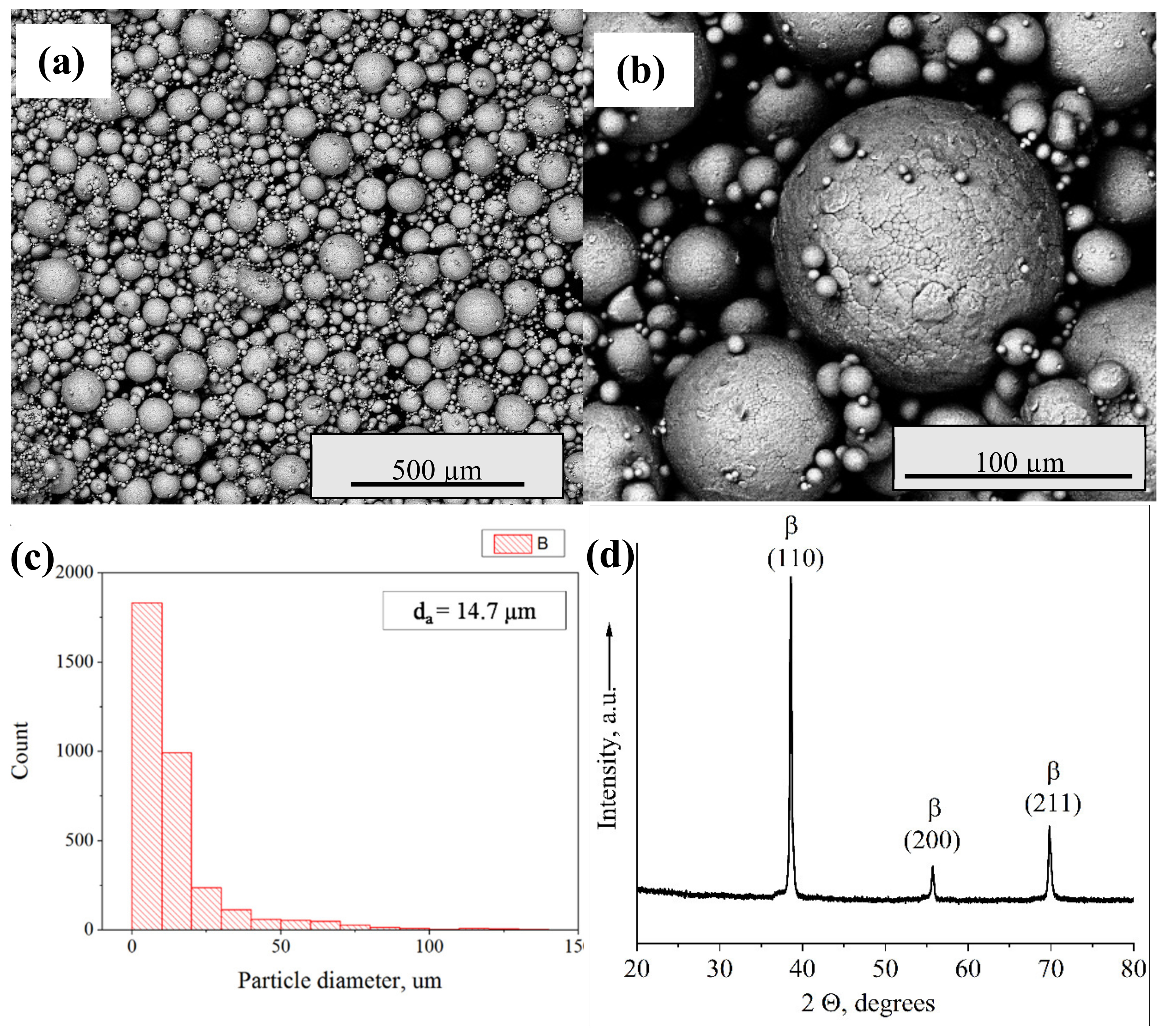

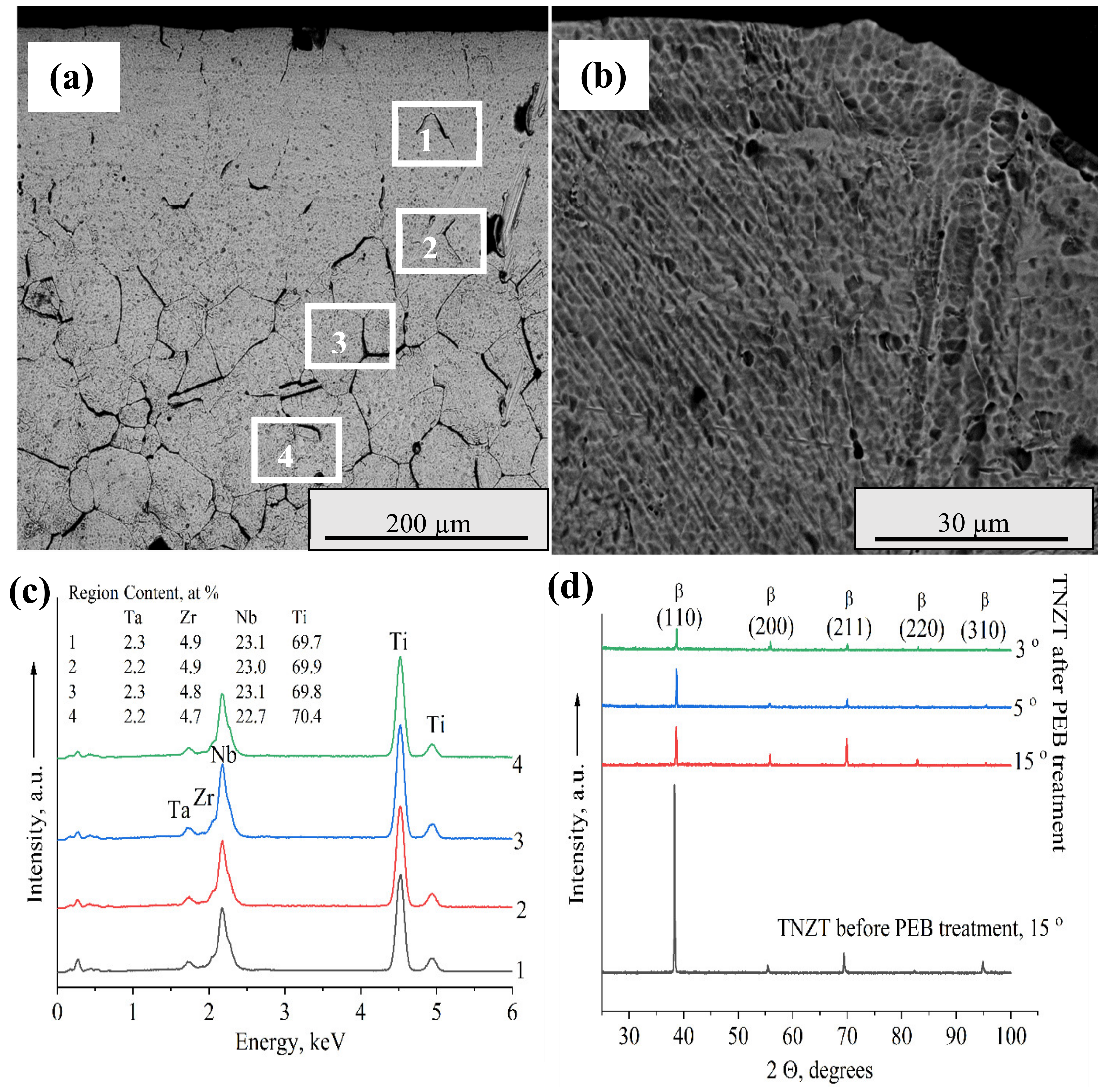

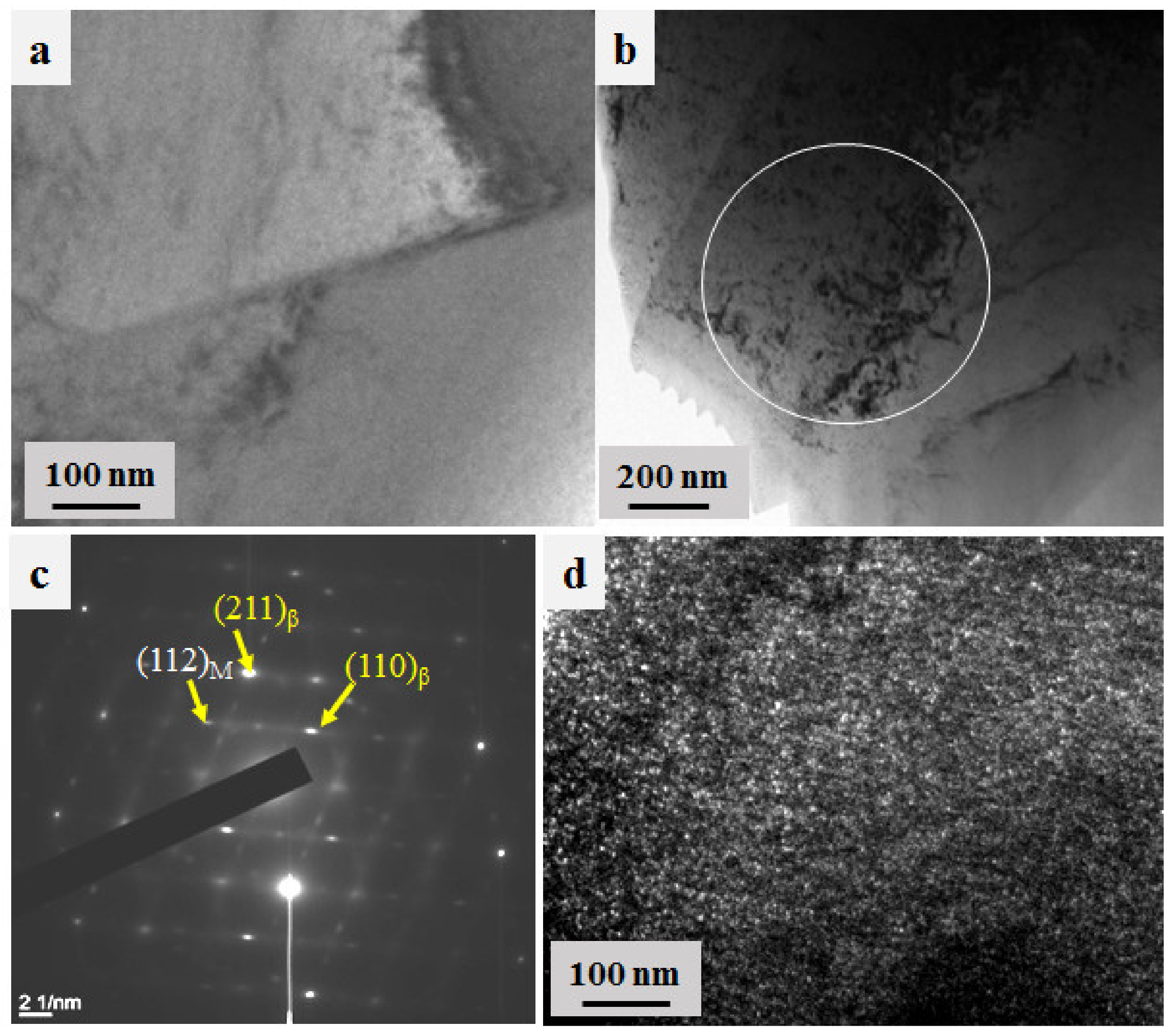


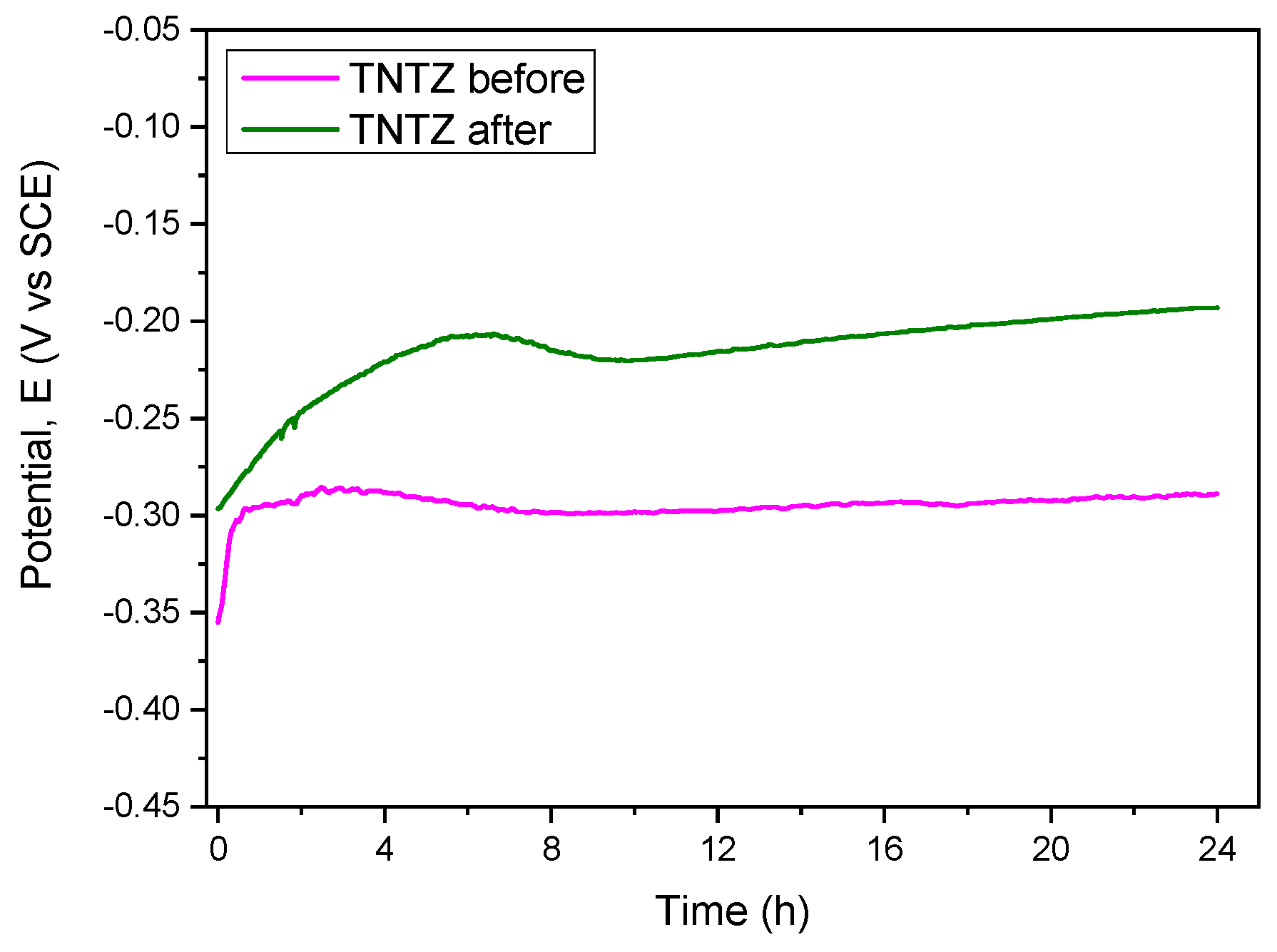


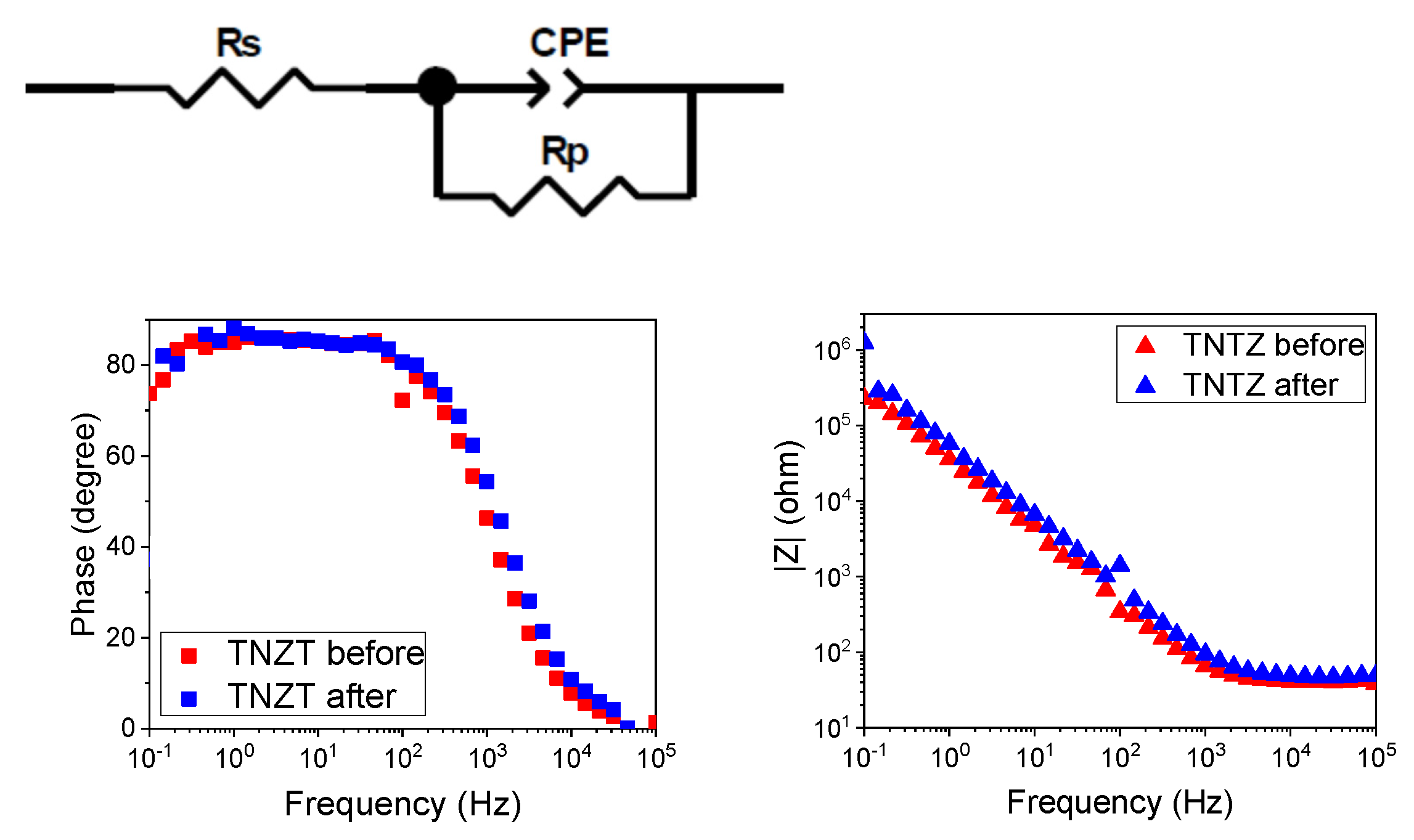
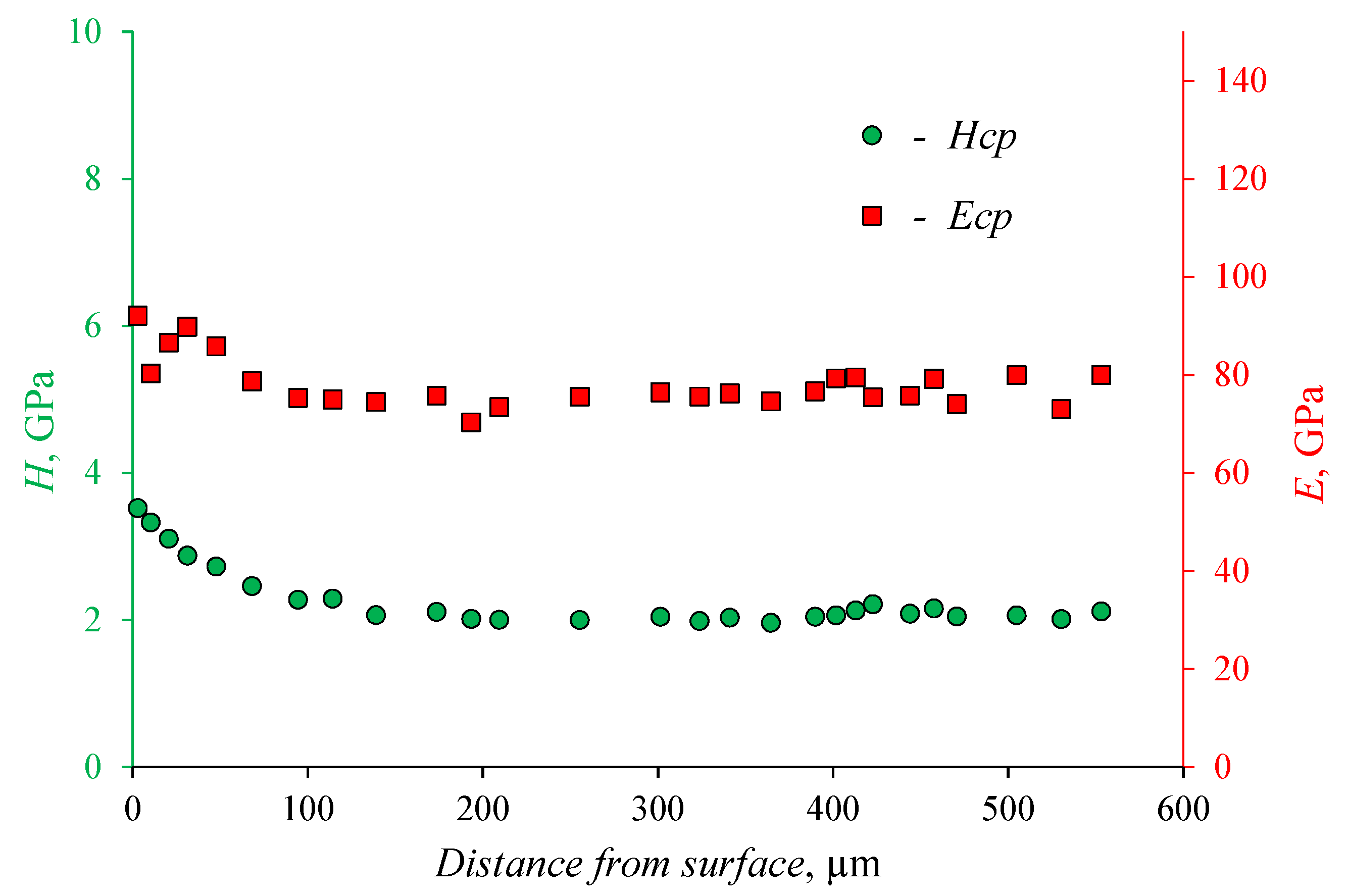
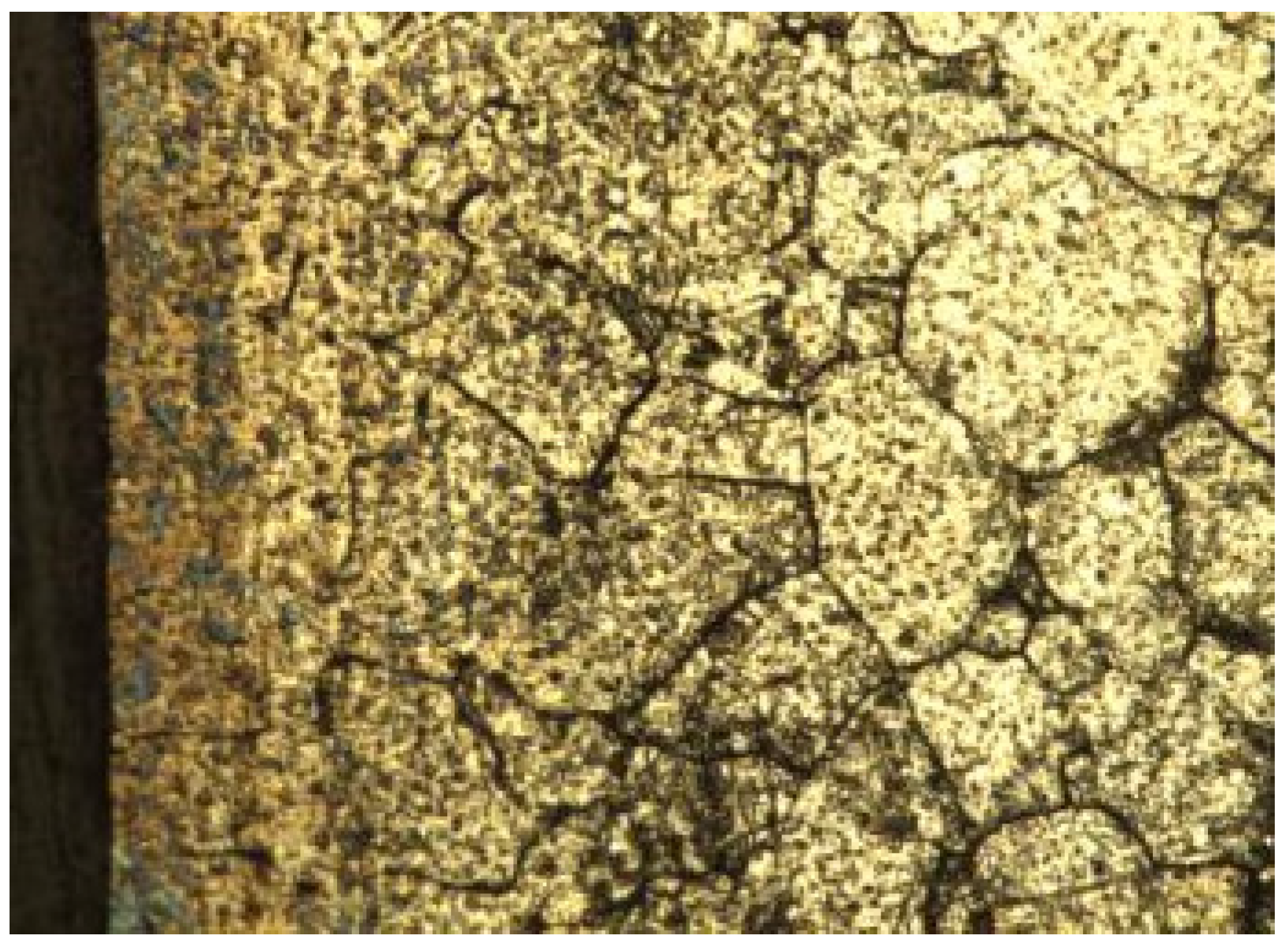
| Layer Thickness, µm | Actual T, °C | Beam Current, mA | Beam Velocity v, mm/S | Loff, mm | Area Energy J/mm2 | Energy J/mm3 |
|---|---|---|---|---|---|---|
| 200 | 842 | 11 | 2409 | 0.1 | 2.740 | 13.699 |
| 100 | 580–600 | 3 | 407 | 0.07 | 6.318 | 63.180 |
| 100 | 520–610 | 3 | 407 | 0.1 | 4.423 | 44.226 |
| 100 | 520–610 | 3 | 497 | 0.1 | 3.622 | 36.217 |
| Sample | D, nm | δ·10−3, nm−2 | ε·10−3 |
|---|---|---|---|
| EBM manufactured TNZT | 43.2 | 0.557 | 1.565 |
| PEB irradiated TNZT | 45.6 | 0.492 | 1.561 |
| Sample | EOC (mV) | Ecorr (mV) | icorr (nA/cm2) | Rp (MΩ·cm2) | Ebrk (V) | CR (µm/year) |
|---|---|---|---|---|---|---|
| TNZT before the PEB | −289 ± 20 | −253 ± 18 | 1.142 ± 0.3 | 17.617 ± 0.2 | 1.20 ± 0.1 | 0.0141 ± 0.007 |
| TNZT after the PEB | −193 ± 16 | −142 ± 23 | 1.633 ± 0.2 | 16.754 ± 0.3 | 1.10 ± 0.1 | 0.0103 ± 0.008 |
| Alloy | Rs (Ω·cm2) | C (μF s(α−1)·cm−2) | α | Rp (kΩ·cm2) |
|---|---|---|---|---|
| TNZT before PEB treatment | 40.4 | 5.00 | 0.95 | 1.55 |
| TNZT after PEB treatment | 45.4 | 2.34 | 0.99 | 1.61 |
Publisher’s Note: MDPI stays neutral with regard to jurisdictional claims in published maps and institutional affiliations. |
© 2021 by the authors. Licensee MDPI, Basel, Switzerland. This article is an open access article distributed under the terms and conditions of the Creative Commons Attribution (CC BY) license (https://creativecommons.org/licenses/by/4.0/).
Share and Cite
Surmeneva, M.; Grubova, I.; Glukhova, N.; Khrapov, D.; Koptyug, A.; Volkova, A.; Ivanov, Y.; Cotrut, C.M.; Vladescu, A.; Teresov, A.; et al. New Ti–35Nb–7Zr–5Ta Alloy Manufacturing by Electron Beam Melting for Medical Application Followed by High Current Pulsed Electron Beam Treatment. Metals 2021, 11, 1066. https://doi.org/10.3390/met11071066
Surmeneva M, Grubova I, Glukhova N, Khrapov D, Koptyug A, Volkova A, Ivanov Y, Cotrut CM, Vladescu A, Teresov A, et al. New Ti–35Nb–7Zr–5Ta Alloy Manufacturing by Electron Beam Melting for Medical Application Followed by High Current Pulsed Electron Beam Treatment. Metals. 2021; 11(7):1066. https://doi.org/10.3390/met11071066
Chicago/Turabian StyleSurmeneva, Maria, Irina Grubova, Natalia Glukhova, Dmitriy Khrapov, Andrey Koptyug, Anastasia Volkova, Yurii Ivanov, Cosmin Mihai Cotrut, Alina Vladescu, Anton Teresov, and et al. 2021. "New Ti–35Nb–7Zr–5Ta Alloy Manufacturing by Electron Beam Melting for Medical Application Followed by High Current Pulsed Electron Beam Treatment" Metals 11, no. 7: 1066. https://doi.org/10.3390/met11071066
APA StyleSurmeneva, M., Grubova, I., Glukhova, N., Khrapov, D., Koptyug, A., Volkova, A., Ivanov, Y., Cotrut, C. M., Vladescu, A., Teresov, A., Koval, N., Tyurin, A., & Surmenev, R. (2021). New Ti–35Nb–7Zr–5Ta Alloy Manufacturing by Electron Beam Melting for Medical Application Followed by High Current Pulsed Electron Beam Treatment. Metals, 11(7), 1066. https://doi.org/10.3390/met11071066








.jpg)



